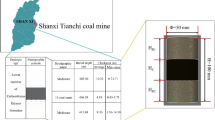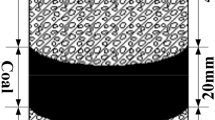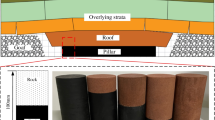Abstract
Underground mining or tunnelling activity is always associated with the composite geological formations. The mechanical properties of layered composite coal–rock subjected to true triaxial stress conditions are significantly different from those under conventional triaxial or uniaxial stress conditions. In this work, we conducted a series of true triaxial tests using the self-developed true-triaxial apparatus to investigate the mechanical response (e.g., deformation, strength, and failure characteristics) of the layered composite coal–rock (CCR). The results show that the uniaxial strength of CCR lies between the strength of pure sandstone and coal, and the direction of the bedding affects the overall strength of the samples. The true triaxial strength of both the pure rock and CCR increases first and then decreases with the increase of the intermediate principal stress. Moreover, for a given loading direction, as the thickness of the sandstone layer increased, the strength of the CCR increases. The deformation of the CCR shows more obvious plasticity than that of the pure sandstone due to the coordinated deformation of the coal and sandstone layers. In addition, a new true triaxial strength criterion expressed by the first and third equivalent principal stress invariants was proposed, which can well describe the strength characteristics of different coal rocks. The stress states, weak structural planes, and localized stress have a great influence on the failure modes of CCR. The local stress concentration near the contact surface promotes the development of the secondary failure fractures. These findings are of great significance in stability designing in deep underground engineering.





















Similar content being viewed by others
Abbreviations
- σ1, σ2, σ3 :
-
Major, intermediate, and minimum principal stresses, respectively (MPa)
- \(\overline{\sigma }_{1}\), \(\overline{\sigma }_{2}\), \(\overline{\sigma }_{3}\) :
-
Effective principal stresses (MPa)
- v1, v2 :
-
Loading rate of σ1 and σ2, respectively (MPa/s)
- b :
-
Intermediate principal stress coefficient
- ε1, ε2, ε3 :
-
Major, intermediate, and minimum principal strain, respectively
- E :
-
Elastic modulus (GPa)
- υ :
-
Poisson's ratio
- θ σ :
-
Stress lode angle
- UCS:
-
Uniaxial compression strength (MPa)
- CCR:
-
Composite coal–rock
- σ m :
-
Mean stress (MPa)
- σ m2 :
-
Effective mean stress (MPa)
- τ oct :
-
Octahedral shear stress (MPa)
- φ :
-
Internal friction angle
- c :
-
Cohesive stress (MPa)
- \(I_{1}^{^{\prime}}\), \(I_{2}^{^{\prime}}\), \(I_{3}^{^{\prime}}\) :
-
The equivalent first, second, and third principal stress invariants (MPa)
- \(S_{{\text{a}}}\) :
-
Equivalent cohesive stress (MPa)
- P p :
-
Pore fluid pressure (MPa)
- A, k :
-
Fitting parameter
References
Bai JW, Feng GR, Wang ZH, Wang SY, Qi TY, Wang PF (2019) Experimental investigations on the progressive failure characteristics of a sandwiched coal–rock system under uniaxial compression. Appl Sci 2019(9):1195. https://doi.org/10.3390/app9061195
Benz T, Schwab R (2008) A quantitative comparison of six rock failure criteria. Int J Rock Mech Min Sci 45(07):1176–1186
Chang C, Haimson BC (2005) Nondilatant deformation and failure mechanism in two long valley caldera rocks under true triaxial compression, Intl. J Rock Mech Min Sci 42:402–414
Chen SD, Tang DZ, Tao S, Xu H, Li S, Zhao JL, Ren PF, Fu HJ (2017) In situ stress measurements and stress distribution characteristics of coal reservoirs in major coalfields in China: implication for coalbed methane (CBM) development. Int J Coal Geol 182:66–84
Chen YL, Zuo JP, Liu DJ, Wang ZB (2019) Deformation failure characteristics of coal–rock combined body under uniaxial compression: experimental and numerical investigations. B Eng Geol Environ 2019(78):3449–3464
Cheng HM, Zhang N, Yang YG, Dong YX, Peng WH (2018) 3-D dynamic evolution analysis of coal–rock damaged field and gas seepage field during the gas extraction process. J Nat Gas Sci Eng 56(08):444–454
Dou LM, Lu CP, Mu ZL, Zhang XT, Li ZH (2006) Rock burst tendency of coal–rock combinations sample. J Min Safe Eng 23(1):43–46
Du F, Wang K, Wang GD, Jiang YF, Xin CP, Zhang X (2018) Investigation of the acoustic emission characteristics during deformation and failure of gas-bearing coal–rock combined bodies. J Loss Prevent Proc 55(09):253–266
Feng XT, Zhang XW, Kong R, Wang G (2016) A novel Mogi type true triaxial testing apparatus and its use to obtain complete stress–strain curves of hard rocks. Rock Mech Rock Eng 49:1649–1662
Feng XT, Haimson B, Li XC, Chang CD, Ma XD, Zhang XW, Ingraham M, Suzuki K (2019) ISRM suggested method: determining deformation and failure characteristics of rocks subjected to true triaxial compression. Rock Mech Rock Eng 52(06):2011–2020
Ferrero AM, Migliazza M, Segalini A, Gulli D (2013) In situ stress measurements interpretations in large underground marble quarry by 3D modeling. Int J Rock Mech Min Sci 60(06):103–113. https://doi.org/10.1016/j.ijrmms.2012.12.008
Goodfellow SD, Tisato N, Ghofranitabari M, Nasseri MHB, Young RP (2015) Attenuation properties of fontainebleau sandstone during true triaxial deformation using active and passive ultrasonics. Rock Mech Rock Eng 48(6):2551–2566
Haimson BC (2006) True triaxial stresses and the brittle fracture of rock. Rock Damage Fluid Transport Part I:1101–1130
Haimson BC, Chang C (2000) A new true triaxial cell for testing mechanical properties of rock, and its use to determine rock strength and deformability of Westerly granite. Int J Rock Mech Min Sci 37(01):285–296
Huang BX, Liu JW (2013) The effect of loading rate on the behavior of samples composed of coal and rock. Int J Rock Mech Min Sci 61(07):23–30
Ingraham M, Issen K, Holcomb D (2013) Response of Castlegate sandstone to true triaxial states of stress. J Geophys Res 118:536–552
Jiang YL, Lian HJ, Nguyen VP, Liang WG (2019) Propagation behavior of hydraulic fracture across the coal–rock interface under different interfacial friction coefficients and a new prediction model. J Nat Gas Sci Eng 68(08):102894. https://doi.org/10.1016/j.jngse.2019.05.007
Jimenez R, Ma X (2013) A note on the strength symmetry imposed by Mogi’s true-triaxial criterion. Inter J Rock Mech Min Sci 64:1721
Kang HP, Zhang X, Si LP, Wu Y, Gao F (2010) In situ stress measurements and stress distribution characteristics in underground coal mines in China. Eng Geol 116(3):333–345
Lade PV (1993) Rock strength criteria: the theories and the evidence. In: Hudson J, Brown ET (eds) Comprehensive rock engineering. Elsevier Inc, London, pp 225–284
Lade PV (2008) Failure criterion for cross-anisotropic soils. J Geotech Geoenviron Eng 134(1):117–124. https://doi.org/10.1061/(ASCE)1090-0241(2008)134:1(117)
Lee YK, Pietruszczak S, Choi BH (2012) Failure criteria for rocks based on smooth approximations to Mohr–Coulomb and Hoek–Brown failure functions. Int J Rock Mech Min Sci 56(12):146–160
Li MH, Yin GZ, Xu J, Song ZL, Jiang CB (2016) A novel true triaxial apparatus to study the geomechanical and fluid flow aspects of energy exploitations in geological formations. Rock Mech Rock Eng 49(12):1–13
Li XB, Feng F, Li DY, Du K, Ranjith PG, Rostami J (2018) Failure characteristics of granite influenced by sample height-to-width ratios and intermediate principal stress under true-triaxial unloading conditions. Rock Mech Rock Eng 51:1321–1345
Li N, Huang BX, Zhang X, Tan YL, Li BL (2019) Characteristics of microseismic waveforms induced by hydraulic fracturing in coal seam for coal rock dynamic disasters prevention. Saf Sci 115(06):188–198
Liu XH, Dai F, Zhang R, Liu JF (2015) Static and dynamic uniaxial compression tests on coal rock considering the bedding directivity. Environ Earth Sci 73(10):5933–5949
Liu XS, Tan YL, Ning JG, Lu YW, Gu QH (2018) Mechanical properties and damage constitutive model of coal in coal–rock combined body. Int J Rock Mech Min Sci 110:145–150
Liu Y, Lu CP, Liu B, Xiao ZY, Zhang H (2019a) Slip and instability mechanisms of coal–rock parting-coal structure (CRCS) under coupled dynamic and static loading. Energy Sci Eng 2019(00):1–17
Liu Y, Lu CP, Zhang H, Wang HY (2019b) Numerical investigation of slip and fracture instability mechanism of coal–rock parting-coal structure (CRCS). J Struct Geol 118(02):265–278
Liu K, Zhang QB, Wu G, Li JC, Zhao J (2019c) Dynamic mechanical and fracture behaviour of sandstone under multiaxial loads using a triaxial hopkinson bar. Rock Mech Rock Eng 52(07):2175–2195. https://doi.org/10.1007/s00603-018-1691-y
Lu J, Yin GZ, Deng BZ, Zhang WZ, Li MH, Chai XW, Liu C, Liu YB (2019a) Permeability characteristics of layered composite coal–rock under true triaxial stress conditions. J Natural Gas Sci Eng 66(06):60–76
Lu J, Yin GZ, Li X, Li MH, Zhang DM, Zhang WZ, Kang QR (2019b) Deformation and CO2 gas permeability response of sandstone to mean and deviatoric stress variations under true triaxial stress conditions. Tunnel Under Sp Tech 84(02):259–272. https://doi.org/10.1016/j.tust.2018.11.023
Lu J, Yin GZ, Gao H, Li X, Zhang DM, Deng BZ, Wu MY, Li MH (2020) True triaxial experimental study of disturbed compound dynamic disaster in deep underground coal mine. Rock Mech Rock Eng. https://doi.org/10.1007/s00603-019-02041-x
Ma XD, Haimson BC (2017) Failure characteristics of two porous sandstones subjected to true triaxial stresses. J Geophys Res 121:09. https://doi.org/10.1002/2016JB013637
Ma XD, Rudnicki JW, Haimson BC (2014) True triaxial tests in two porous sandstones: experimental failure characteristics and theoretical prediction. In: 48th US rock mechanics/geomechanics symposium (ARMA 14-7286)
Ma XD, Rudnicki JW, Haimson BC (2017a) Failure characteristics of two porous sandstones subjected to true triaxial stresses: applied through a novel loading path. J Geophys Res 122:04. https://doi.org/10.1002/2016JB013637
Ma XD, Rudnicki JW, Haimson BC (2017b) The application of a Matsuoka–Nakai–Lade–Duncan failure criterion to two porous sandstones. Int J Rock Mech Min Sci 92(02):9–18
Mogi K (1971) Fracture and flow of rocks under high triaxial compression. J Geophys Res 76:1255–1269
Robert C, Denis EG, Maria HL, Paul MT (1993) Stress measurements in high-stress zones using the modified doorstopper technique. Can Geotech J 30(6):991–1002. https://doi.org/10.1139/t93-096
Tan YL, Yu FH, Ning JG, Zhao TB (2015) Design and construction of entry retaining wall along a gob side under hard roof stratum. Int J Rock Mech Min Sci 77(07):115–121
Tan YL, Liu XS, Ning JG, Lu YW (2017) In situ investigations on failure evolution of overlying strata induced by mining multiple coal seams. Geotech Test J 40(02):244–257
Tan YL, Liu XS, Shen B, Ning JG, Gu QH (2018) New approaches to testing and evaluating the impact capability of coal seam with hard roof and/or floor in coal mines. Geomech Eng 14(04):367–376
Togashi Y, Kikumoto M, Tani K, Hosoda K, Ogawa K (2018) Detection of deformation anisotropy of tuff by a single triaxial test on a single specimen. Int J Rock Mech Min Sci 108(08):23–36
Wang T, Jiang YD, Zhan SJ, Wang C (2014) Frictional sliding tests on combined coal–rock samples. J Rock Mech Geotech Eng 6(03):280–286
Wang K, Du F, Zhang X, Wang L, Xin CP (2017) Mechanical properties and permeability evolution in gas-bearing coal–rock combination body under triaxial conditions. Environ Earth Sci 76:815. https://doi.org/10.1007/s12665-017-7162-z
You MQ (2009) True-triaxial strength criteria for rock. Int J Rock Mech Min 46(1):115–127
Zhao XG, Wang J, Cai M, Ma LK, Zong ZH, Wang XY, Su R, Chen WM, Zhao HG, Chen QC, An QM, Qin XH, Qu MY, Zhao JS (2013) In-situ stress measurements and regional stress field assessment of the Beishan area, China. Eng Geol 163(08):26–40. https://doi.org/10.1016/j.enggeo.2013.05.020
Zhao ZH, Wang WM, Dai CQ, Yan JX (2014) Failure characteristics of three-body model composed of rock and coal with different strength and stiffness. Transact Nonferrous Metals Soc China 24(05):1538–1546
Zhao ZH, Wang WM, Wang LH, Dai CQ (2015) Compression–shear strength criterion of coal–rock combination model considering interface effect. Tunnel Under Sp Tech 47(03):193–199
Zhao J, Feng XT, Zhang XW, Yang CX, Zhou YY (2018) Time-dependent behaviour and modeling of Jinping marble under true triaxial compression. Int J Rock Mech Min Sci 110(10):218–230
Zhou YY, Feng XT, Xu DP, Fan QX (2016) Experimental investigation of the mechanical behavior of bedded rocks and its implication for high sidewall caverns. Rock Mech Rock Eng 49(09):3643–3669
Zuo JP, Wang ZF, Zhou HW, Pei JL, Liu JF (2013) Failure behavior of a rock-coal–rock combined body with a weak coal interlayer. Int J Min Sci Tech 23(06):907–912
Acknowledgements
This study was financially supported by the National Natural Science Foundation of China (51434003, 51874053, and 51674049). Dr. Lu wish to thank the China Scholarship Council for funding the study and research at the University of Toronto. Thanks for the guidance of our doctoral supervisor professor GZ. Yin, who pass away of illness in June 2019.
Author information
Authors and Affiliations
Contributions
JL designed the experimental plan and wrote, revised this paper, also responded to the editor and reviewers. JL and HG conducted the experiments. XL checked and improved the language. GY, DZ and GH proposed some suggestions and provided funding support.
Corresponding authors
Ethics declarations
Conflict of interest
The authors declare no conflicts of interest.
Additional information
Publisher's Note
Springer Nature remains neutral with regard to jurisdictional claims in published maps and institutional affiliations.
Rights and permissions
About this article
Cite this article
Lu, J., Huang, G., Gao, H. et al. Mechanical Properties of Layered Composite Coal–Rock Subjected to True Triaxial Stress. Rock Mech Rock Eng 53, 4117–4138 (2020). https://doi.org/10.1007/s00603-020-02148-6
Received:
Accepted:
Published:
Issue Date:
DOI: https://doi.org/10.1007/s00603-020-02148-6




